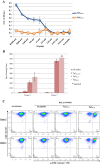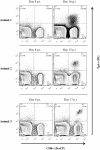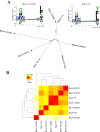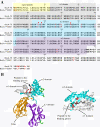Use of "one-pot, mix-and-read" peptide-MHC class I tetramers and predictive algorithms to improve detection of cytotoxic T lymphocyte responses in cattle
- PMID: 24775445
- PMCID: PMC4018993
- DOI: 10.1186/1297-9716-45-50
Use of "one-pot, mix-and-read" peptide-MHC class I tetramers and predictive algorithms to improve detection of cytotoxic T lymphocyte responses in cattle
Abstract
Peptide-major histocompatibility complex (p-MHC) class I tetramer complexes have facilitated the early detection and functional characterisation of epitope specific CD8+ cytotoxic T lymphocytes (CTL). Here, we report on the generation of seven recombinant bovine leukocyte antigens (BoLA) and recombinant bovine β2-microglobulin from which p-MHC class I tetramers can be derived in ~48 h. We validated a set of p-MHC class I tetramers against a panel of CTL lines specific to seven epitopes on five different antigens of Theileria parva, a protozoan pathogen causing the lethal bovine disease East Coast fever. One of the p-MHC class I tetramers was tested in ex vivo assays and we detected T. parva specific CTL in peripheral blood of cattle at day 15-17 post-immunization with a live parasite vaccine. The algorithm NetMHCpan predicted alternative epitope sequences for some of the T. parva CTL epitopes. Using an ELISA assay to measure peptide-BoLA monomer formation and p-MHC class I tetramers of new specificity, we demonstrate that a predicted alternative epitope Tp229-37 rather than the previously reported Tp227-37 epitope is the correct Tp2 epitope presented by BoLA-6*04101. We also verified the prediction by NetMHCpan that the Tp587-95 epitope reported as BoLA-T5 restricted can also be presented by BoLA-1*02301, a molecule similar in sequence to BoLA-T5. In addition, Tp587-95 specific bovine CTL were simultaneously stained by Tp5-BoLA-1*02301 and Tp5-BoLA-T5 tetramers suggesting that one T cell receptor can bind to two different BoLA MHC class I molecules presenting the Tp587-95 epitope and that these BoLA molecules fall into a single functional supertype.
Figures








Similar articles
-
Designing bovine T cell vaccines via reverse immunology.Ticks Tick Borne Dis. 2012 Jun;3(3):188-92. doi: 10.1016/j.ttbdis.2011.12.001. Epub 2012 Jan 9. Ticks Tick Borne Dis. 2012. PMID: 22621863 Review.
-
CD8 T-cell responses against the immunodominant Theileria parva peptide Tp249-59 are composed of two distinct populations specific for overlapping 11-mer and 10-mer epitopes.Immunology. 2016 Oct;149(2):172-85. doi: 10.1111/imm.12637. Epub 2016 Jul 25. Immunology. 2016. PMID: 27317384 Free PMC article.
-
Systematic Determination of TCR-Antigen and Peptide-MHC Binding Kinetics among Field Variants of a Theileria parva Polymorphic CTL Epitope.J Immunol. 2022 Feb 1;208(3):549-561. doi: 10.4049/jimmunol.2100400. Epub 2022 Jan 14. J Immunol. 2022. PMID: 35031580 Free PMC article.
-
BoLA-6*01301 and BoLA-6*01302, two allelic variants of the A18 haplotype, present the same epitope from the Tp1 antigen of Theileria parva.Vet Immunol Immunopathol. 2015 Sep 15;167(1-2):80-5. doi: 10.1016/j.vetimm.2015.06.007. Epub 2015 Jun 20. Vet Immunol Immunopathol. 2015. PMID: 26139380
-
The bovine cytotoxic T cell: MHC restriction and antigen-specificity.Verh K Acad Geneeskd Belg. 2000;62(3):211-28. Verh K Acad Geneeskd Belg. 2000. PMID: 10905120 Review.
Cited by
-
Characterization of binding specificities of bovine leucocyte class I molecules: impacts for rational epitope discovery.Immunogenetics. 2014 Dec;66(12):705-18. doi: 10.1007/s00251-014-0802-5. Epub 2014 Sep 4. Immunogenetics. 2014. PMID: 25186069 Free PMC article.
-
Sequence diversity between class I MHC loci of African native and introduced Bos taurus cattle in Theileria parva endemic regions: in silico peptide binding prediction identifies distinct functional clusters.Immunogenetics. 2016 May;68(5):339-52. doi: 10.1007/s00251-016-0902-5. Epub 2016 Feb 6. Immunogenetics. 2016. PMID: 26852329
-
Improved Prediction of Bovine Leucocyte Antigens (BoLA) Presented Ligands by Use of Mass-Spectrometry-Determined Ligand and in Vitro Binding Data.J Proteome Res. 2018 Jan 5;17(1):559-567. doi: 10.1021/acs.jproteome.7b00675. Epub 2017 Nov 14. J Proteome Res. 2018. PMID: 29115832 Free PMC article.
-
Theileria parva antigens recognized by CD8+ T cells show varying degrees of diversity in buffalo-derived infected cell lines.Parasitology. 2018 Sep;145(11):1430-1439. doi: 10.1017/S0031182018000264. Epub 2018 May 6. Parasitology. 2018. PMID: 29729680 Free PMC article.
-
BNT162b2 vaccine induces neutralizing antibodies and poly-specific T cells in humans.Nature. 2021 Jul;595(7868):572-577. doi: 10.1038/s41586-021-03653-6. Epub 2021 May 27. Nature. 2021. PMID: 34044428 Clinical Trial.
References
Publication types
MeSH terms
Substances
LinkOut - more resources
Full Text Sources
Other Literature Sources
Molecular Biology Databases
Research Materials
Miscellaneous

